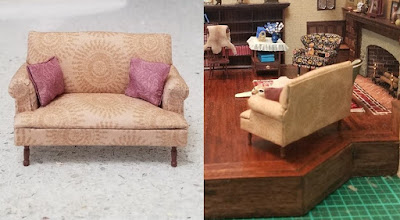Among the chairs in the library is a fiddle back rocking chair. (I am learning new furniture terms on this build, too.)
My
original plan was to ask a woman who has previously created some custom,
laser-cut, half-scale kits for me to create a kit for a fiddle-back rocker. [Carrie sent me a very interesting article on
creating kits yourself and having them laser cut by a service, but I got the
article after finishing the chair. Keeping it in mind for the future.] Anyway, flush
with success from the desk chair, I decided to use my Silhouette Cameo and my
sandwich method (two layers of chipboard and two layers of wood scrapbooking
paper glued together, with the edges coated with stainable wood putty) for those
elements that could not easily be cut from strip wood. I made the fiddle back, curved arm supports and
rockers using this method; the rest is simple strip wood of various widths and
thicknesses. Aside from that, I simply
stained, sanded, glued and varnished (kind of boring), so I didn't take pictures of the process.
Here is the finished chair.
I
think it looks OK, and it actually rocks! I had a little video of it rocking, but for some reason it will not upload.
Here
it is, next to the desk. I have put down
a temporary rug (I will be
cross-stitching a rug once I find a pattern I like) so that you can see the
chair, because the dark furniture tends to disappear against the dark floor.
Speaking
of rugs, I am still working on the rug that will go under the zebra skin. It is being worked with one strand of DMC
floss on 36-count Evenweave. For some
reason, I have really hated doing the outer border, so I keep finding excuses
not to work on it. That part is finally
done though, so I just need to finish a bit of the inner border and fill in the
middle, which I hope will go faster. Below
is my progress so far under the "zebra skin" I printed on velvet
paper. I will be trimming that out a bit
with embroidery floss to give it a mane.
There
will likely be no update next week, as I will be busy preparing for
Thanksgiving this week and next, and won't have time to work on the library. ☹ There are still a few chairs left to build,
but I plan to go back to finishing the lighting and woodwork, get a ceiling in
place, and fill those bookshelves!! I'll
also be working on a few more smaller elements for the room.
As
always, thanks for stopping by, and for those of you in the U.S., best wishes
for a very happy Thanksgiving!

























